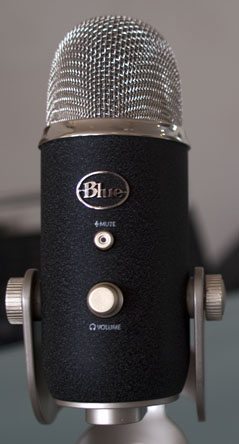 Last year I reviewed the Yeti USB microphone. At the time, I really liked the microphone, and over the last year using it, my opinion of it has only improved. Honestly, when it comes to my needs, the Yeti was definitely a 10. When they released the Yeti Pro, I was intrigued to see what they did to improve on it, and fortunately I was offered the opportunity to review one.
Last year I reviewed the Yeti USB microphone. At the time, I really liked the microphone, and over the last year using it, my opinion of it has only improved. Honestly, when it comes to my needs, the Yeti was definitely a 10. When they released the Yeti Pro, I was intrigued to see what they did to improve on it, and fortunately I was offered the opportunity to review one.
So, as the philosopher Nigel Tufnel once observed: “You’re on ten here, all the way up, all the way up, … Where can you go from there? Where?” Where indeed. Let’s take a look at the Yeti Pro, and see how it compares to it’s non-pro cousin.
The Yeti Basics
Just like the Yeti, the Yeti Pro has a triple capsule design that can be used to cover four different recording patterns:
- Stereo
- Cardiod
- Omni
- Bidirectional
The Yeti Pro Additions
The first thing you will notice about the pro is color. The pro is decked out in black instead of the silver finish of the original Yeti.
The black finish is a nice touch, and the stand on the Yeti Pro also has a titanium finish. There is no longer a THX logo on the front of the microphone. I asked about this, and the rep explained that the THX certification for microphones is not continuing, but all the specs on the Yeti Pro meet or exceed the Yeti.
A less cosmetic change are the connections. The Yeti Pro has the USB and Headphone jack of the Yeti, but also adds a stereo XLR jack on the bottom.
It also retains the standard threaded mic stand mount.
First Impressions
As with the Yeti, and other blue products, a lot of thought and design went into the packaging. The Yeti comes with a short manual, an XLR breakout cable (for the right and left channels of the XLR output) and a USB cable.
Not only is the packaging design attractive, it is also very informational. They include a nice chart to break down which of the four recording patterns are best for different applications.
The Specs
Having XLR outputs is enough to label this a Pro, but they also bumped the specifications of the microphone. Here are the specs for the Yeti Pro, with the Yeti’s in blue and parenthesis where different:
Microphone
Power Required/Consumption: 5V 500mA (USB)/48V DC (analog) (up from 150mA)
Sample Rate: 192 kHz (up from 48 kHz)
Bit Rate: 24bit (up from 16bit)
Capsules: 3 Blue-proprietary 14mm condenser capsules
Polar Patterns: Cardioid, Bidirectional, Omnidirectional, Stereo
Frequency Response: 20Hz – 20kHz
Sensitivity: 4.5mV/Pa (1 kHz)
Max SPL: 120dB (THD: 0.5% 1kHz)
Headphone Amplifier
Impedance: >16 ohms
Power Output (RMS): 130 mW
THD: 0.009%
Frequency Response: 15 Hz – 22 kHz
Signal to Noise: 114dB (up from 100dB)
Setup
As with the Yeti, setup with the Yeti Pro was fairly simple. It is a little different in terms of drivers, but I was able to plug and play on my MacBook Pro, and after installing the driver for Windows 7, had not issue using the microphone with Bootcamp on my MacBook Pro.
Controls
The Yeti Pro has a dial to control gain (sensitivity) and the recording pattern on the back of the microphone:
The front of the microphone contains controls to mute the microphone and to control the volume on the headphone:
These controls only work when you are using the microphone in USB mode. If you are using the XLR connections, the headphone volume and mute do not work. The Blue tech I talked to explained that the this part of the microphone is powered by the USB port, so naturally they are not available in XLR mode. This should not be an issue, though, as all those functions are better controlled on the mixing board when using the XLR connections.
When using the USB connection, a solid red light on the mute button means the microphone is on and working, a blinking light means that mute is on. I find this an odd way of displaying the information. If the the LED was not on the button, I think it would make more sense. It does not take long to keep that straight, though. Also, since volume can now be controlled digitally, the volume button does not have a clear minimum or maximum setting. You simply turn clockwise to make it louder, and counter-clockwise to make it softer.
Performance
I have replaced my Yeti with the Yeti Pro and have had no issues with the new microphone. I think my demonstration from my review of the original Yeti on recording patterns still suffices for those features.
Unfortunately, I am not a pro, so I can’t really show off the difference in quality. My primary use for a microphone is to record audio for web-delivered content. Frankly, the higher sample and bit rates offered by the Yeti Pro are not going to be readily apparent in my use of the microphone, since I tend to compress the audio and was not utilizing the full quality from the Yeti. I guess the best analogy is my dSLR. Sure I take a 10 Megapixel picture, but by the time I resize them for the web, you are not getting the full effect. However, it captures more information when I first take the picture, so the end-result is better than my camera phone.
Is It One Louder?
As I mentioned up top, I was a huge fan of the Yeti, and I wondered how will they would improve it. Did it go to 11? Actually I think it goes to 12. The bump in specifications (even if I can’t fully exploit them for my applications) takes it to 11, and then the addition of the XLR output takes it to 12.
I am not a professional musician, but I have good friends who are. I have also filled in on sound boards at times, so I know professionals can get a little sentimental about their microphones. The flexibility of using this microphone as a USB mic in casual settings, and then turning around and hooking it up to a professional sound board should be appealing to pros and semi-pros.
Is It Worth It?
The answer to this is the universal answer: it depends. If you are looking to have the best microphone you can for USB, Blue has taken their top-of-class Yeti and made it more responsive. If you are looking for the ability to go beyond USB and hook up your microphone to a professional sound board, the stereo XLR output will be worth it. If you need a microphone for recording podcasts, and you don’t need the XLR outputs, then you are probably better off saving a $100 and sticking with the Yeti. You are not really settling with that microphone.
DJI Mic Mini (2 TX + 1 RX), Detail-Rich Audio, Wireless Lavalier Microphone for Camera/Android, 2-Person Vlog, Team Production
45% OffMini Mic Pro (Latest Model) - Professional Wireless Microphone for iPhone, iPad, Android, Lavalier Microphone for Video Recording - iPhone Mic Crystal Clear Recording with USB-C for Content Creators
17% OffProduct Information
| Price: | $249.99 |
| Manufacturer: | Blue Microphones |
| Pros: |
|
| Cons: |
|


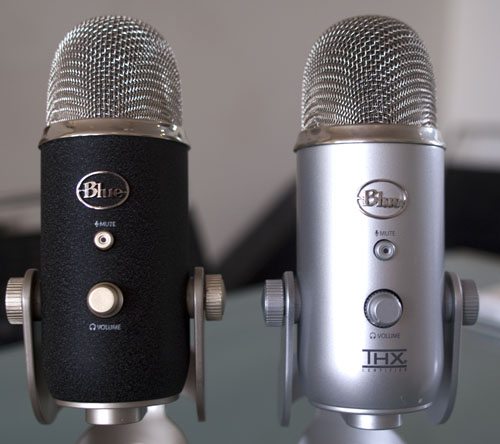
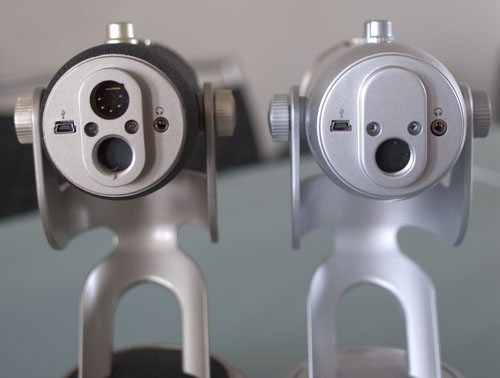
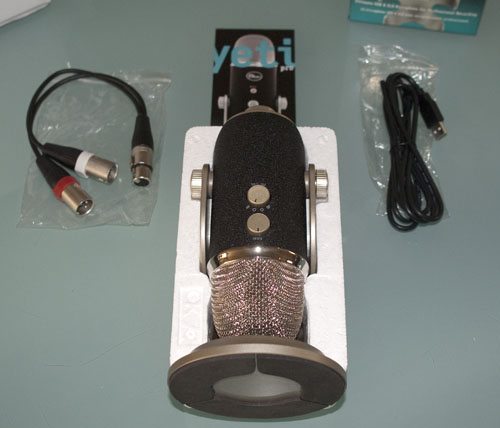
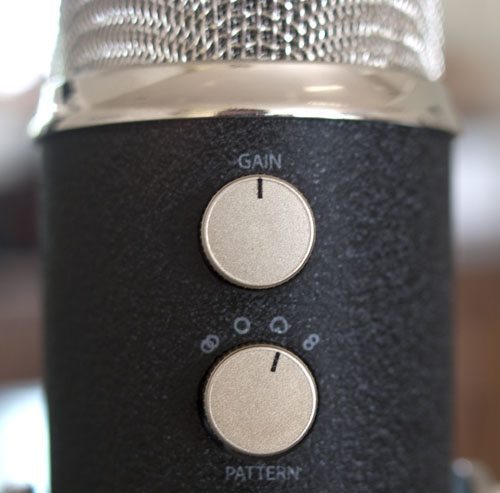
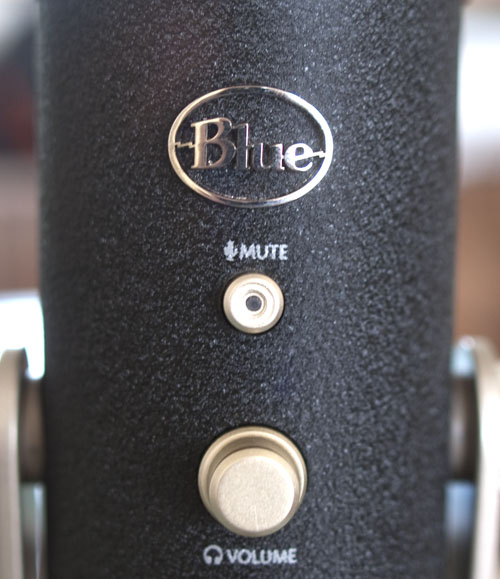
![Small but Mighty - The DJI Mic Mini Transmitter is small and ultralight, weighing only 10 g, [1] making it comfortable to wear, discreet, and aesthetically pleasing on-camera. Detail-Rich Sound - Mic Mini delivers high-quality audio. A 400m max trans...](https://m.media-amazon.com/images/I/31k+wYzRSbL._SL160_.jpg)

Gadgeteer Comment Policy - Please read before commenting
Can this be used to improve the quality of video conferencing (i.e., use this as the mic rather than the one built into the webcam).
Definitely. ANY microphone you connect to your Windows or Mac PC will improve the audio on any videoconferencing.
@Daniel,
For a conference call, any conference call, you should run, not walk, to the nearest online store and get a high quality, usb, external mic from a reputable audio firm. My office standardized on Samson (because I owned Samson mics and everyone loved mine), but Blue is a great brand too.
The difference a Samson or Blue mic makes, compared to a built in mic or a low end mic, is huge. I turned an office full of skeptics into an office full of evangelists with my mic. My work now has a dozen of these mics, up from zero just three years ago.
The current office complaint is that someone should make a high quality mic that can plug into a telephone conference system, because we’ve gotten so spoiled with the usb mics.
@Bryan and thsu
Thanks…I did buy one…can’t wait to test it. I play D&D with friends physically and one from China and one from Oregon, so I am hoping this will help the sound quality (bought a good digicam which helped the video).
P.S. Didn’t buy Blue, though it looks great. It was a bit above what I can afford. But I’ll be curious to see how the one I bought performs. It had good Amazon reviews. Maybe, I’ll post a mini-review in the comments (if that doesn’t violate a policy on this site!).
What a great review! Thanks. Finally I can see the specs side by side of the Yeti and Yeti Pro.
I’ve been trying to find a simple way to do high quality voice recordings in a portable system. I do radio and television voice over for a living and I like to be able to record from a hotel room on occasion when I’m not in my studio.
I have an Mbox with an AKG 414 which is great “broadcast quality” but the Mbox is designed for Protools (which is not my DAW of choice) and is a bit of a pain to deal with. In the studio I use a Lawson U47. I don’t hardly expect the Yeti to compare with my Lawson ($2,000) or even the AKG ($1,000) but I never cease to be amazed at how good some of these new less-expensive mics are. Blue, RODE, and some others are making $200-$300 mics that rival my spendy-er ones!
I’m ordering the Yeti Pro today and I can’t wait to do an A-B test with some of my other mics to see how close it can come quality-wise to more costly mics.
Very nice article and pics. I am a big fan of Yeti as well and have enjoyed producing numerous voice recordings. I used to miss having a shockmount for Yeti and folks at Blue solved that with the Blue Radius recently. It works really well for me in isolating sounds. At the price of this mic, its a great bargain for the excellent experience.
@Redshifter I actually got to review the Radius. Here is the link: http://the-gadgeteer.com/2011/10/29/the-radius-for-yeti-review/
I don’t really notice a difference between the Yeti and my iMac’s built-in mic. Actually the Mac’s mic is quieter (no background hum). I tested it with a QuickTime Pro recording and with a Skype video conference with my brother overseas. I kept switching between the Yeti and the built-in mic; my brother (who didn’t know what I was up to), had a slight preference for the built-in mic, but ultimately said they sounded the same. What gives?
@Macauley86 I’m not sure what gives, I found an incredible difference with my MacBook Pro’s mic. I recall having an issue initially when I thought it was using the Yeti, and was still using the internal mic, but once I straightened it out, it was profoundly different. If you go to my original review of the Yeti (http://the-gadgeteer.com/2010/08/11/blue_yeti_mic/) the test I did shows the difference. I’m having a hard time believing the iMac built in is that much better than the MBP.
Hi Gang: I’m very interested in trying this mic (or one like it) for internet radio. I’m currently using a Samson C01U, but the fact that it has both XLR and USB outs make it really attractive for what I’m looking for. I’d like to have it plugged into my mixer and my PC, to be able to switch from live (XLR) to recording (USB). Can you use both outputs at the same time? Are there any other mics with both USB and XLR Connectivity?
There is a nice FAQ on their site:
http://www.bluemic.com/yetipro/#/faq/
Here is what they said:
Can I use both USB and XLR at the same time?
Yeti Pro should only be plugged into one source (USB or XLR) at a time. All mic functions operate in digital mode, while in analog mode, the mute and headphone out functions do not operate (these are not useful in an analog recording situation).
Blue was at Vidcon this past weekend offering 40% off and I scored this wonderful mic for $150! That’s less than I paid for the little Sennheiser I attadh to my dslr. So, if you’re on a ramen eating budget and happen to attend conferences and such, look for the folks from Blue. Find out where they’re going and score yourself a deal. 😉
How far can I extend the USB cord? Can I add 6 feet to the cord that comes with the Yeti Pro? -Thanks.
I don’t know John. I have not tried, and do not have a longer cable to experiment with. I imagine cable quality would have an impact. You may want to check with their support http://www.bluemic.com/salesandsupport/servicerequest.php
Thanks, Bryan. I submitted a request. I will post any response I get.
I’m just a little curious. I make hip hop music. Do you think that this mic would be a good choice for that?? I need something that will sound professional..